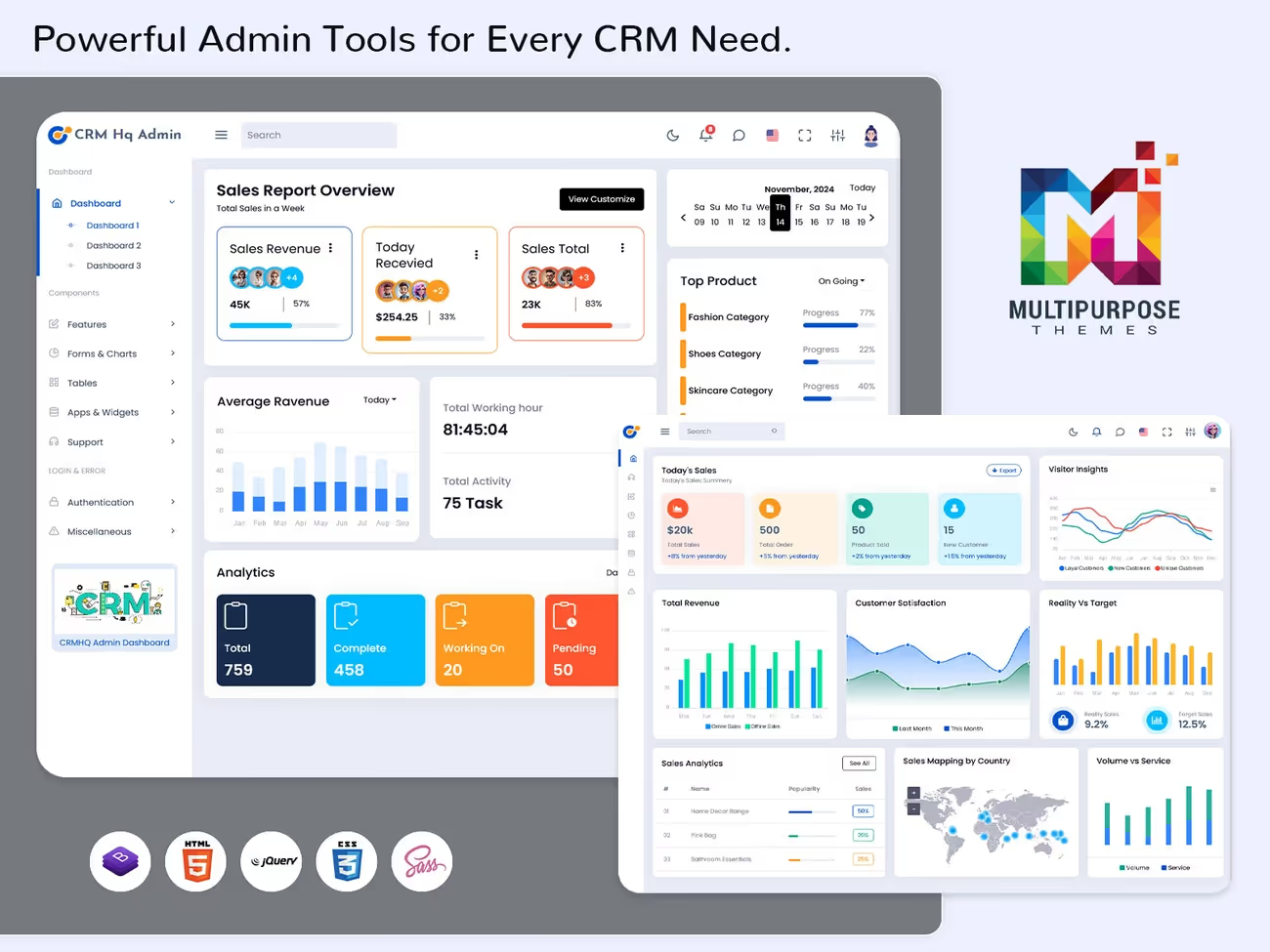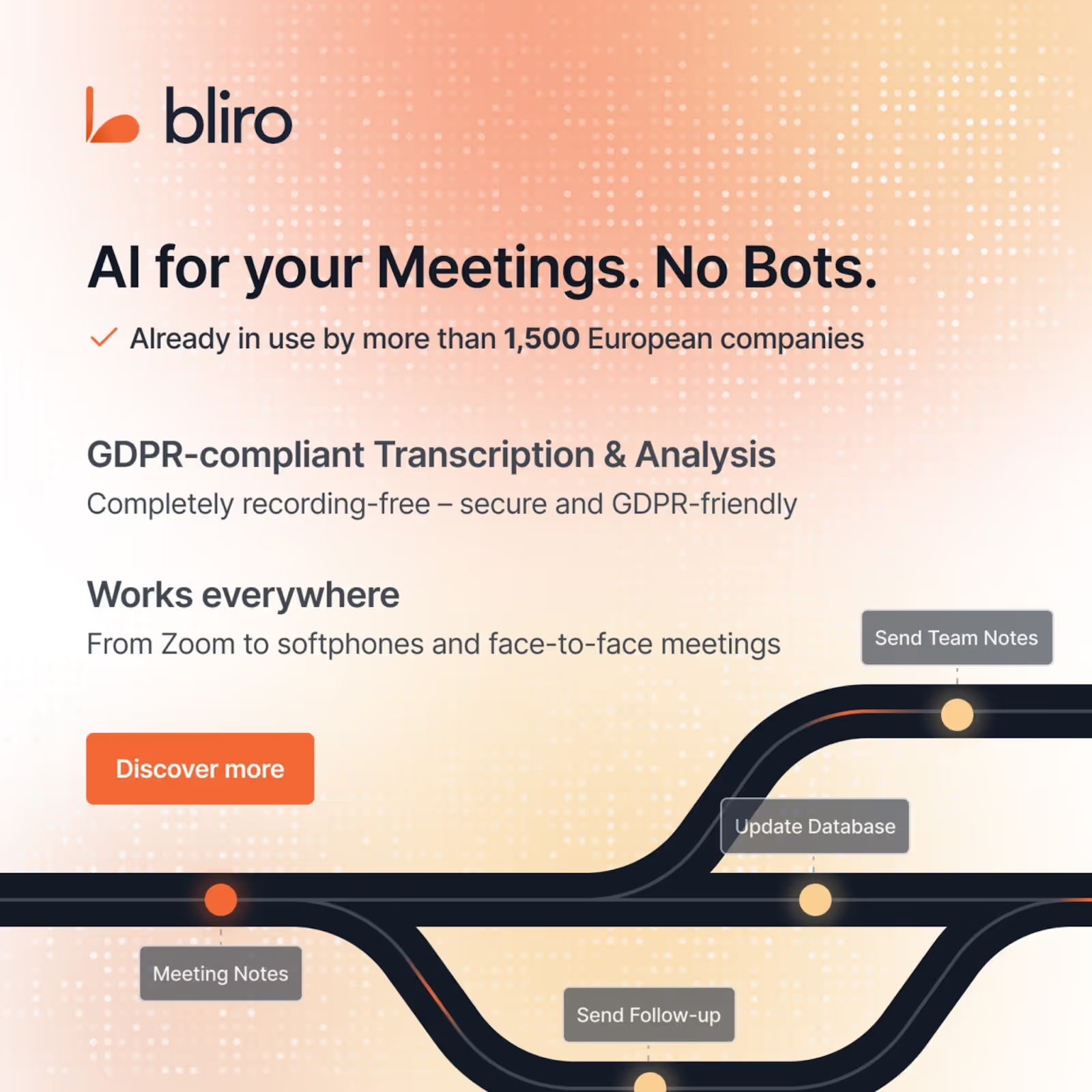Effectively managed sales teams can achieve up to 2.6 times higher ROI by focusing on targeted talent development and prioritizing high-quality sales opportunities. However, one alarming truth often goes unnoticed: 40 to 60 percent of all deals fall through in the final phase - right when customers are seemingly ready to buy. This discrepancy clearly highlights that traditional sales leadership methods are no longer enough in today’s competitive market.
Efficient sales team management can truly make the difference between an average business and a high-performing enterprise. One particularly noteworthy trend: By 2026, 65 percent of B2B sales professionals are expected to replace gut-based decision-making with data-driven sales analytics. That’s why you need more than just a clear vision and a strong sales strategy - you also need modern sales enablement tools that promote transparency and accountability.
Innovative solutions like Bliro help streamline your sales process by automatically transcribing sales conversations and extracting actionable insights for strategic decision-making. In this comprehensive guide, you’ll discover how top-performing sales leaders drive success by defining clear roles, fostering psychological safety within their sales teams, and implementing structured development strategies.
The Changing Role of the Sales Manager

The sales landscape is currently undergoing a profound transformation that presents sales managers with entirely new challenges. Demand for sales and business development professionals surged by an impressive 95% in Q3 2024 - while the expectations and requirements for these roles are changing fundamentally.
What Defines a Sales Manager Today?
Modern sales managers must do much more than simply hit sales targets. In a world where, by 2026, 65% of B2B sales reps are expected to replace gut-based decisions with data-driven sales analytics, technical literacy is essential. Successful sales leaders are distinguished by a unique combination of strategic thinking, digital fluency, and the ability to proactively shape the customer experience.
One particularly striking data point: According to Forrester, around one million B2B sales jobs in the U.S. were projected to be eliminated by 2020 due to Robotic Process Automation taking over many traditional tasks. Still, experts emphasize that complex, strategic sales processes - such as partner management and relationship building - will continue to demand highly skilled professionals. Yet, according to LinkedIn, only 1.5% of all sales reps possess these advanced competencies.
A Shift in Sales Leadership Philosophy
A fundamental paradigm shift is occurring in leadership style. Rather than acting as controllers, successful sales managers are increasingly stepping into the role of sales coaches for their teams. This is no coincidence: Numerous studies show that coaching-based leadership has a significant positive impact on employee satisfaction, engagement, and performance.
It’s important to understand that coaching is not the same as training. Rather, it is a dialog-driven, development-oriented process. Leaders who coach demonstrate measurable improvements in communication skills, problem-solving abilities, and emotional intelligence. They also foster a culture of continuous learning - an invaluable advantage in a sales environment where demands are constantly increasing.
To embrace this leadership shift, sales managers need a broad and refined skill set, including:
- Purposeful questioning techniques and active listening
- Encouraging self-reflection among team members
- Solution-oriented approaches to overcoming challenges
- Constructive and actionable feedback
Managing Hybrid and Remote Sales Teams
With the rise of flexible work models, the way sales teams are managed is changing too. Hybrid work has become the new normal - not just a perk. Sales professionals now expect to work remotely several days a week.
This shift brings specific challenges: Sales leaders experience less visibility, fewer direct interactions, and reduced control over workflows and sales processes. Yet remote sales leadership also has advantages: reduced office space costs and more efficient use of working time due to fewer informal interruptions.
The key to success lies in trust-based, data-driven, and asynchronous leadership. Especially critical are:
- Regular, structured 1:1 meetings instead of ad-hoc check-ins
- Clear performance goals and measurable KPIs
- Transparent, open communication and mutual trust
Sales tools like Bliro help create clarity and alignment in hybrid sales environments. By automatically transcribing sales calls and meetings, Bliro allows managers to extract valuable insights - even without being physically present. This makes targeted coaching and continuous development possible - regardless of where your team is located.
In an era where automation increasingly handles simple sales tasks, the ability to inspire, coach, and strategically guide teams becomes the defining success factor for tomorrow’s sales managers.
Structuring Sales Teams Strategically
The strategic setup of your sales team plays a critical role in overall business success. More than 52% of companies have fundamentally restructured their sales strategy or business model in the past three years to adapt to changing market conditions. A well-thought-out sales structure is the key to sustained growth and competitive advantage.
Field Sales vs. Inside Sales: Differences and Synergies
Inside sales and field sales differ fundamentally in how they operate. Inside sales reps typically work remotely, using phone, email, or digital communication tools to engage with clients, while field sales professionals visit customers in person. Each approach comes with distinct strengths and challenges:
- Field sales enables a high degree of personal interaction and fosters strong customer relationships - but it also involves higher travel and personnel costs.
- Inside sales excels in cost efficiency, faster response times to customer inquiries, and greater scalability.
The most effective strategy is to combine both approaches. One inside sales rep can manage up to 1,000 customers remotely, while the field team focuses on high-value clients. This “tandem servicing” model - where each team member handles the tasks they’re best at - greatly enhances resource efficiency. Bliro supports this hybrid sales structure through transparent meeting documentation accessible to both teams, ensuring consistency, shared insights and automatic To-Do’s.
Adapting Your Sales Structure to the Market and Target Audience
A successful sales structure is always aligned with the needs of your target audience. Customer-centric sales organizations categorize their clients into segments based on value, typically assessed through Customer Equity Value. This classification guides how different customer groups are served and prioritized.
To build an effective sales organization, you first need to evaluate which sales channels are most relevant for your customer segments. According to a Harvard Business Review study, 50% of sales professionals in high-performing companies reported that their sales processes are tightly monitored, strictly enforced, and/or automated.
Key factors influencing your sales team structure include:
- The number of salespeople available
- The use of various sales channels (e.g., phone, email, social media)
- How different customer segments are managed
- The reporting structure and sales leadership framework
Sales Strategies for 2025: Flexible and Data-Driven
Future-ready sales strategies are built around two pillars: flexibility and data analytics. The most widely used sales technology is CRM optimization (61.4%), followed by analytics and business intelligence (BI) tools (48.5%). Additionally, 35.3% of businesses cite sales automation as a top strategic priority.
Data-driven sales refers to the practice of using analytical insights to shape sales strategies, tailor customer interactions, and optimize the entire sales funnel. Core components include:
- Lead Scoring: Prioritizing leads based on behavioral patterns and demographic data
- Performance Analysis: Identifying the most effective sales channels and strategies
- Personalized Outreach: Leveraging customer data to deliver highly tailored solutions
However, data-driven sales does not mean personal relationships become irrelevant. On the contrary, 2025 is shaping up to favor a hybrid sales model - one that intelligently combines digital and face-to-face selling. Tools like Bliro play a central role here by analyzing sales conversations and uncovering insights that fuel data-backed decisions.
A flexible sales strategy also allows your team to respond swiftly to market shifts. Make sure to diversify your communication channels and align them with your customers’ preferred methods. This ensures that your messaging resonates and boosts the overall effectiveness of your sales team.
Efficient Processes and Smart Tools

In today’s competitive sales landscape, powerful tools and streamlined processes are essential to your sales team’s success. According to recent studies, companies that invest in sales automation significantly increase productivity while also improving customer service.
Best CRM for Sales Teams: Key Selection Criteria
Choosing the right CRM system is critical to driving sales performance. An effective CRM enables your business to strengthen customer relationships, operate more efficiently, and foster long-term loyalty. When selecting a CRM solution, be sure to consider the following criteria:
- Ease of Use: Your sales reps will only embrace the software if it’s intuitive and user-friendly.
- Data Protection & GDPR Compliance: Ensure the provider uses European servers and offers transparent data privacy policies.
- Integrations: Seamless integration with your existing tools is vital for a smooth and efficient workflow.
- Flexibility: Assess how adaptable the CRM is to your contract needs and customization requirements.
Especially important: While large enterprises may benefit from robust on-premise solutions, cloud-based CRMs are often the better choice for small to mid-sized companies without dedicated IT infrastructure.
Bliro as a Tool for Meeting Transparency and Follow-Ups

While CRM systems form the backbone of efficient sales processes, Bliro fills a critical gap: comprehensive documentation of customer conversations. This smart tool transcribes and summarizes meetings automatically - without appearing as a distracting bot during the call.
One standout feature is Bliro’s GDPR compliance without the need for explicit consent. It transcribes conversations without recording audio or video, and processes all data exclusively on servers located in Germany. This ensures:
- Full focus on your conversation partner - no need for manual note-taking
- Automatic capture of key insights and follow-ups
- Direct integration with CRM platforms like Salesforce and HubSpot
Integrating Bliro into your sales workflow has been proven to increase deal close rates by 22% and average deal size by 11%, thanks to AI-powered coaching and internal sharing of sales best practices.
Sales Navigator for Teams: Driving B2B Lead Generation
LinkedIn Sales Navigator has become an indispensable tool for B2B sales teams. With access to qualified data from millions of professionals, it enables highly targeted outreach and real-time tracking of buyer intent signals.
Core features that empower sales teams include:
- Advanced Search Filters: Search by company, job title, location, or industry to quickly identify high-potential leads - enhancing targeting accuracy and boosting conversion rates.
- Lead Recommendations: AI-driven suggestions identify new leads that match your ideal customer profile - saving your team valuable time.
- CRM Integration: Seamless connection with Salesforce or HubSpot ensures automatic data sync and a centralized dashboard for all client interactions.
A Unified Sales Tech Stack for Maximum Performance
The combination of a tailored CRM system, Bliro for meeting documentation, and Sales Navigator for intelligent prospecting creates the technological backbone of modern, high-performing sales teams. Together, these tools provide the transparency and operational efficiency needed for your sales reps to focus on what truly matters: building valuable, long-term customer relationships.
Boosting Team Performance Through Targeted Development

The targeted development of sales professionals has a direct impact on overall business outcomes. Studies show that sales departments with standardized onboarding processes can increase the productivity of new hires by an impressive 54%.
Onboarding and Continuous Sales Training
An effective onboarding process starts on day one and lays the foundation for long-term sales success. It should not consist of disjointed steps, but instead follow a strategic, coherent sequence. One critical insight: On average, new sales reps need 381 days to reach the performance level of seasoned colleagues - a well-structured onboarding program can significantly reduce this ramp-up time.
High-performing companies standardize the delivery of essential sales skills and clearly define what success looks like in terms of business goals, buyer personas, and sales conversations. In parallel, ongoing training ensures that key activities and goals are regularly practiced and updated within the team.
Coaching with Real-Time Data and Conversation Analytics
Modern sales coaching uses technology to improve performance in measurable ways. With AI-powered conversation analysis, sales managers can evaluate customer calls in real time and provide highly targeted feedback. While coaching traditionally occurred after the sales conversation, tools like Bliro now make in-the-moment coaching possible - an approach proven to increase close rates significantly.
Bliro empowers sales leaders by capturing conversation patterns and performance signals live, enabling a more agile and data-informed coaching process.
Goal Setting and Personalized Success Plans
Effective goal setting motivates sales reps and provides them with a clear roadmap for their work. According to research, three out of four employees value goal-setting conversations with their managers. However, for goals to be meaningful, they must follow the SMART framework: Specific, Measurable, Achievable, Relevant, and Time-bound.
For sustainable success, sales teams should align around a balanced mix of goals:
- Quantitative goals (e.g., revenue, new customer acquisition)
- Qualitative goals (e.g., customer satisfaction, relationship building)
- Personal development goals (e.g., skill enhancement, role growth)
Just as important as setting goals is defining clear action steps to achieve them. Sales managers should regularly assess whether each team member is on track and intervene immediately if progress stalls - offering guidance, resources, or coaching as needed.
Customer Centricity and Long-Term Relationships
Sustainable customer relationships are more than just a sales trend - they are a fundamental necessity for future-oriented companies. In the B2B space, one thing is clear: anyone aiming for long-term success must shift focus from one-time transactions to ongoing partnerships.
Personalization in the Sales Process
Personalization in B2B sales goes far beyond using someone’s first name in an email. It means tailoring your products and services precisely to the needs and challenges of each company. This has become increasingly vital: While 74% of B2B companies expected their websites to generate more than half of their sales in 2023, customer expectations for personalized experiences have also grown rapidly.
To achieve true personalization, first-party data is essential, as it provides real-time insight into buyer behavior and intent. Tools like Bliro offer valuable support by analyzing sales conversations and capturing customer preferences - without violating GDPR compliance.
Collaboration with Customer Success Teams
Customer Success Management (CSM) serves as the bridge between initial sales and long-term customer success. Unlike traditional customer service, which focuses on resolving problems, CSM is proactive - aimed at fostering value and growth for the customer.
This shift requires a new operating model: Instead of working in silos, sales and customer success teams must collaborate closely. The crucial moment in this collaboration occurs immediately after the deal is closed. Ideally, your customer should receive a follow-up call from the CSM team right away. Additionally, regular joint planning sessions involving both sales and CS reps are highly recommended to align goals and strategies.
Customer Satisfaction as a Performance Metric
Customer satisfaction has a direct impact on the stability and longevity of your business relationships. While it can be challenging to measure - given that different individuals use different benchmarks - there are proven customer success metrics you can rely on:
- Customer Health Score: Tracks relationship strength by monitoring satisfaction levels, product usage, and perceived value over time
- Net Promoter Score (NPS): Measures how likely customers are to recommend your business to others - a key indicator of brand trust
- Personalized Communication: Targeted and individualized messaging has been shown to significantly increase customer loyalty
One final note: Authentic customer feedback is incredibly valuable and should always be taken seriously. Here, Bliro plays a vital role as a meeting documentation tool - capturing, organizing, and analyzing customer insights in a compliant and structured way. These insights help your sales team make data-informed decisions and improve relationship management over time.
Conclusion
Successful sales leadership today requires much more than traditional management methods. The shift from controlling manager to strategic sales coach, the adjustment of team structures to fit evolving market demands, and the adoption of data-driven tools form the foundation of high-performing sales organizations. One particularly impressive insight: Teams led with modern approaches achieve up to 2.6 times higher ROI.
Your sales strategy must be flexible enough to respond to rapidly changing customer needs and market conditions. If you intelligently combine inside sales and field sales, tools like Bliro can support both models simultaneously through automated meeting documentation, creating visibility and alignment between distributed teams.
There’s no doubt that data-driven decision-making plays a central role in future-proofing your sales organization. With Bliro, key customer interactions are automatically captured - without disrupting workflows - and analyzed to uncover deep insights into customer preferences. All of this happens GDPR-compliantly, with no need for explicit consent, since neither video nor audio recordings are stored.
Targeted coaching of your sales reps leads to significantly improved results. Bliro’s conversation analytics offer concrete insights for personalized feedback and facilitate the sharing of best practices across the entire team. In the end, long-term customer relationships are built through consistent personalization and strong collaboration between Sales and Customer Success.
As expectations for sales teams continue to rise, modern leadership styles, strategic team structures, and intelligent tools to ensure that your team remains competitive. Rely on this winning combination - not just to hit short-term sales goals, but to build sustainable customer relationships and secure long-term business success.




